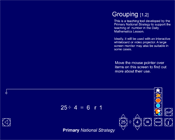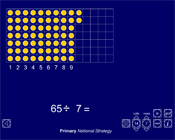Consolidation and practice
These resources are to support children in guided or independent work. Roll over the highlighted resources for a description.
Grouping

This interactive teaching program (ITP) is an ICT-based tool to support the exploration of division. Grouping ITP allows the child or teacher to model division as grouping and to link this process to jumps on a number line. It can also be used to introduce children to remainders and to apply their knowledge through setting similar problems that can be solved using the image displayed.
Remainders after division

This interactive teaching program (ITP) is an ICT-based tool to support the exploration of number and calculation. Remainders after division ITP can be used to demonstrate division as grouping, and to develop children's understanding of remainders and the notation for division. Keeping the number of counters fixed but changing the number of rows demonstrates the effect of changing the divisor in the calculation. Children can explore the effect different divisors have on the remainder.
Opportunities to use and apply
Confirming learning
Ask probing questions such as:
- Work out the missing number:
 × 2 = 56
× 2 = 56
- How does knowing that 10 × 6 = 60 help you to calculate the answer to 72 ÷ 6?
- Make up some division questions that have no remainder. How did you do this? How did you know they don’t have a remainder? Make up some division questions that have a remainder of one. How did you do it?
- Jack says that 71 ÷ 4 = 17 remainder 5. Can he be correct?
 Calculating
Calculating

